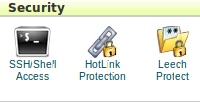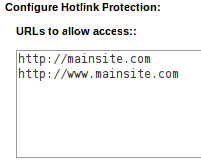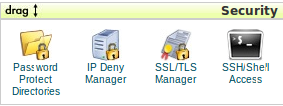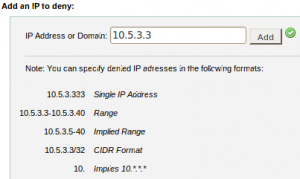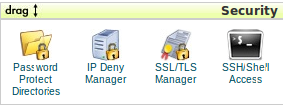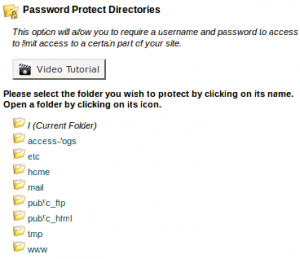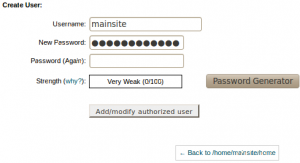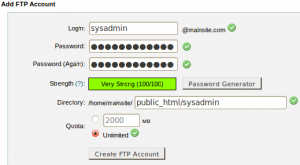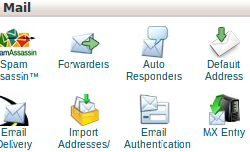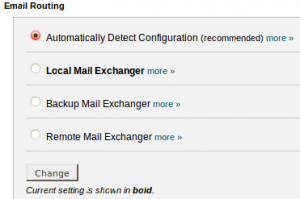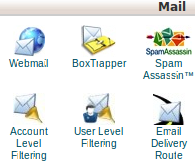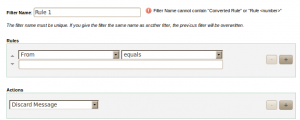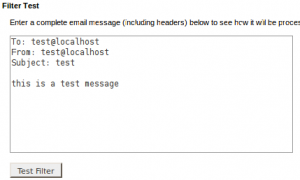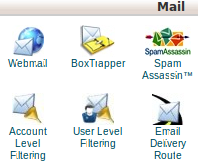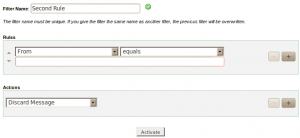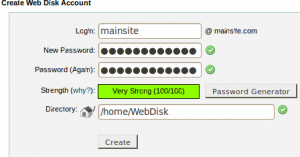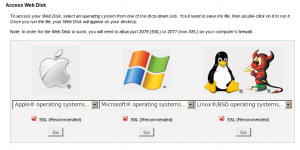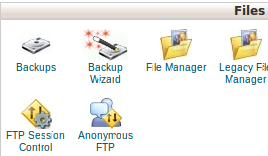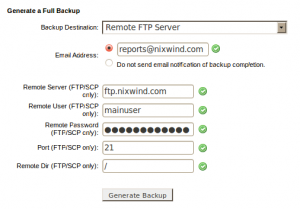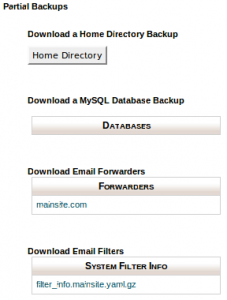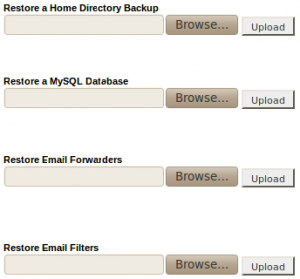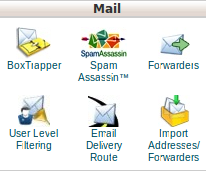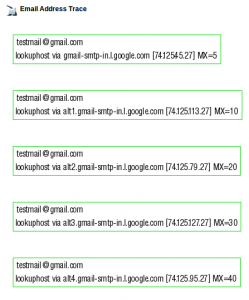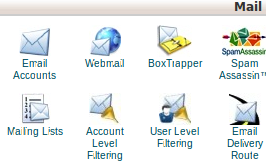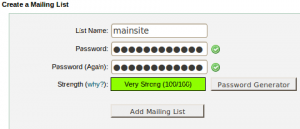You can use hotlink protection to keep other sites from linking to your images, videos, and other files.
1) To access Hotlink Protection, click on “Hotlink Protection” button on the home page under Security.
2) To Enable / Disable HotLink Protection, click the Enable button on the HotLink Protection main page.
In configure hotlink protection add urls of sites that you wish to access your files.
Direct access to certain file extensions can be blocked by adding them under ” Block direct access for these extensions”.
Click the checkbox to allow users to access the content directly by entering the specific file’s URL into a browser.
Requests for content can be redirected by entering a URL under the “Redirect request to this URL”.
Click the button “Submit” to save the entire setting.
IP Deny Manager is use to block single IP address or a range of IP addresses to prevent them from accessing your site.
1) To access the IP Deny Manager , click on the “IP Deny Manager” on the home page under Security.
2) Enter the IP address that you want to block in the IP Address field.We can also add a range of IP’s.
Click on the Add button.
3) Blocked IP addresses are seen under “Current IP addresses being blocked”.
To unblock an IP , Click Remove button near appropriate IP address
You can protect directories within your site with a login and password, by using this feature.
1) Click on “Password Protect Directories” button in Security session.
2)To password protect a directory, select the directory which you want to protect
a) Click on the option button “
b) Enter a name that you choose for the protect directory will appear.
c) Click “save”, to save the password protected file name.
3) You will need create a user and password under the”Create User”.
a) Enter the username.
b) Enter a strong new password or use “Password Generator”.
c) Click “Add/modify authorized user” to save the authorized user.
4) The new user’s name will be added to the list box under the Authorized Users heading.
We can also delete the desired users from the listbox by clicking “Delete User”.
To remove password protection from the directory, uncheck “Password protect this directory”.
Adding an FTP account will allow users to access the domain’s folder on the server’s hard disk.
1) For creating FTP accounts, click “FTP Accounts” in the “File” area.
2) To create a FTP account
a) Enter a username in the text box “Login“.
b) In the Password box, type the account’s password or generate a strong password by clicking the “Password Generator” button.
c) Enter the path to the “Directory” to which this FTP account has access.
d) Disk space that will be allocated to the FTP account can be set in “Quota” field.
e) Click Create FTP Account.
3) The new FTP account should be now displayed in the list below.
By Clicking the links we can change a password,Adjust quota,Delete an account or Configure an FTP client of an existing FTP Account.
4) Special FTP Accounts are seen under “Special FTP Accounts”.
Special FTP Accounts are FTP accounts that cannot be deleted.
You can set custom MX entry for your domain with cPanel. This is done to set mail server of your domain to a remote server.
1) Click on “MX Entry” under the Mail area in cPanel.
2) For MX Entry Choose the option “” under email routing.
Click on the button “Change” to save the settings.
3) Under Add New Record, set the priority for the new MX Entry (Lower values denote higher priority,0 is the highest priority).
Add hostname of the new mail exchanger in the text box “Destination“.
Click “Add New Record” to store the changes.
4) Existing MX Entries are seen under ” MX Records“. You can edit or delete these MX entries.
Email filters can be set on cPanel, with which you can filter the unwanted mails from a specific sender or with a specific subject.
1) Account Level Filtering
With Account level filtering we can set common mail filtering rules for all email accounts on the account
To add an Account Level Filter, Click on the “Account Level Filtering” in the Mail area.
Click “Create a New Filter”
It will go to “Edit Filter for All Mail On Your Account” as shown below.
a) Desired rule name on , “Filter Name” field
b) Select an item from the combo box under Rule, here you can specific the parameter that you want to filter
c) Select an operator from the second combo box under Rule.
d) Enter the any characters or words in the text box for filtering, here you can give the exact content that you want to filter
e) You can add and remove rules by clicking the + and – buttons.
f) Select a function from “Action” combo box. here you can set an action to discard or route the mail.
Click “Activate” to save the settings.
Created Filters can be Tested using “Filter Test“.
Type a test email message in the text box. Click on “Test Filter“, test result will be shown.
2) User Level Filtering
As the name suggests with user level filtering you can set email filters for each email account.
1) Click on the “User Level Filtering” in the Mail area.
Select a user from the User list.
Click “Create a New Filter”.
It will go to “Edit Filter ” as shown below.
a) Desired rule name on , “Filter Name” field
b) Select an item from the combo box under Rule, here you can specific the parameter that you want to filter
c) Select an operator from the second combo box under Rule.
d) Enter the any characters or words in the text box for filtering, here you can give the exact content that you want to filter
e) You can add and remove rules by clicking the + and – buttons.
f) Select a function from “Action” combo box, here you can set an action to discard or route the mail in wanted way
Click “Activate” to save the settings.
Created Filters can be Tested using “Filter Test“.
Type a test email message in the text box. Click on “Test Filter“, test result will be shown.
WebDisk allows you to manage files associated with your website using your operating system’s interface. You can navigate, upload and download files to and from your web server through Web Disk.
1) For creating a Web Disk , click on “Web Disk” under Files section on your cPanel.
To configure a Web Disk
a) Enter a username in the Login field.
b) Enter your desired password into the Password field. A password generator is their to generate a strong password.
c) Specify the directory to which that you want the webdisk to startup.
d) Click on the button “Create” to save the entire settings.
On the next page, you can select the operating system and you will get clear instructions to set webdisk for your OS
a) Choose your operating system (OS), Windows, Mac, or Linux.
b) Click “Go” under the appropriate operating system to download the script file.
c) Open and run the script file.
When the Web Disk configuration is completed successfully, a new window containing your website’s content will be opened on your computer.
2) The existing WebDisk Accounts can be seen under “Web Disk Account Management”.
There are links to change password and delete a webdisk account in WebDisk Account Management.
The Backup Menu under cPanel files section allows a user to backup or restore all or parts of their account.
1) Click on Backups in the Files area.
2) Click on “Download or Generate a Full Website Backup”
A full backup includes all of the files in your home directory. This backup can be mainly used to move your account to another cPanel server.
You can specify the back up destination with “Backup Destination:” drop down. Backup can be placed in the homedirectory or send to a remote server with the options you specify.
3) For Partial BackUp’s.
a) For Only Home directory backup, click on the button “Home Directory”.
b) For MySQL database backup, click on the button “Databases”.
c) For Email Forwarders backup, click on the button “Forwarders“.
d) For Email Filters backup, click on the button “System Filter Info“.
4) Restore a Backup
This feature allows you to restore files and databases separately.
Restoring options is under Partial Backups
a) First one is to restore a home directory backup. Define where the backups should be stored by clicking the button “Browse“. Click the button “Upload” to restore the home directory backup.
b) To Restore a MySQL Database click the button browse under “Restore a MySQL Database”. Click the button “Upload” to restore the MySQL Database.
c) To Restore Email Forwarders click the button browse under “Restore Email Forwarders”.Click the button “Upload” to restore the Email Forwarders.
d) To Restore Email Filters click the button browse under “Restore Email Filters“. Click the button “Upload” to restore email filters.
Email Delivery Route option is to verify specific path that will be taken by an outgoing message when send from the server.
1) Click on the “Email Delivery Route” in the Mail area.
2) Enter an email address in the text box to see the delivery path
click “Show Route”
3) An Example of Email Address Trace is shown below.
Mailing lists can be used to send messages frequently to a large amount of
people for things such as newsletters and product updates.
1) Click on the “Mailing Lists” in the Mail area.
2) Add a Mailing List
a) Enter the “list name” in the text box.
b) Give a secure password.
c) Click “Add Mailing List” to create the new mailing list.
To modify and add email addresses to a list, click on “modify“.


